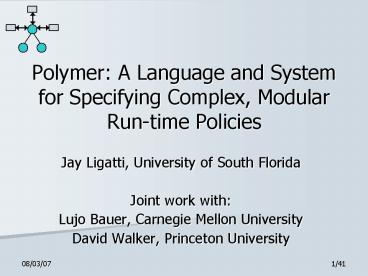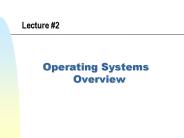Polymer: A Language and System for Specifying Complex, Modular Run-time Policies
Title:
Polymer: A Language and System for Specifying Complex, Modular Run-time Policies
Description:
So higher-order policies (superpolicies) can compose simpler policies (subpolicies) ... Composing security policies with Polymer (PLDI 2005) ... –
Number of Views:38
Avg rating:3.0/5.0
Title: Polymer: A Language and System for Specifying Complex, Modular Run-time Policies
1
Polymer A Language and System for Specifying
Complex, Modular Run-time Policies
- Jay Ligatti, University of South Florida
- Joint work with
- Lujo Bauer, Carnegie Mellon University
- David Walker, Princeton University
2
Security Policy Enforcement
- News flashSoftware sometimes does bad stuff
- Bugs
- Malicious design
- One protection mechanism Run-time program
monitoring - Monitoring software interposes whenever an
untrusted application is about to execute a
security-relevant action
3
Program Monitoring
- Monitors ensure that software dynamically
adheres to constraints specified by a security
policy - Practical examples
- Stack inspection, firewalls, network auditors,
sandboxing, intrusion detection systems,
Untrusted Target
Program Monitor
Executing System
Open(f,w)
Open(f,w)
Open(f,w) is OK
4
Security Policies Become More Complex
- As software becomes more sophisticated(i.e.,
enters new domains) - Multi-user and networked systems
- Electronic commerce
- Medical databases (HIPAA, EU Data Protection Law)
5
Security Policies Become More Complex
- As software becomes more sophisticated(i.e.,
enters new domains) - Multi-user and networked systems
- Electronic commerce
- Medical databases (HIPAA, EU Data Protection Law)
- As we tighten overly relaxed policies
- Insecure default configurations disallowed
- Downloading .doc files requires warning
6
Security Policies Become More Complex
- As software becomes more sophisticated(i.e.,
enters new domains) - Multi-user and networked systems
- Electronic commerce
- Medical databases (HIPAA, EU Data Protection Law)
- As we tighten overly relaxed policies
- Insecure default configurations disallowed
- Downloading .doc files requires warning
- As we relax overly tight policies
- All applets sandboxed (JDK 1.0) vs. only
unsigned applets sandboxed (JDK 1.1)
7
Managing Complexity via Centralization
Application with policyscattered throughout
Application with centralized policy
Policy contains - Security code - When to run
the security code
Scattered policy is hard to find and reason
about
Centralized policy is easier to find and reason
about
8
Related Work Managing Policy Complexity via
Centralization
- General monitoring systems
- Java-MaC Lee, Kannan, Kim, Sokolsky,
Viswanathan 99 - Naccio Evans, Twyman 99
- Policy Enforcement Toolkit Erlingsson,
Schneider 00 - Aspect-oriented software systems Kiczales,
Hilsdale, Hugunin, Kersten, Palm, Griswold 01
- Language theory
- Semantics for AOPLs Tucker, Krishnamurthi 03
Walker, Zdancewic, Ligatti 03 Wand, Kiczales,
Dutchyn 04 - Automata theory
- Security automata Schneider 00 Ligatti,
Bauer, Walker 05
9
Beyond Centralization Composition
- Policy centralization is not enough
- Need methodology for organizing a complex
centralized policy - All of the cited efforts lack a flexible
methodology for decomposing complex policies into
simpler modules
10
Polymer Contributions
- Polymer
- Is a fully implemented language (with formal
semantics) for specifying run-time policies on
Java code - Provides a methodology for conveniently
specifying and generating complex monitors from
simpler modules - Strategy
- Make all policies first-class and composeable
- So higher-order policies (superpolicies) can
compose simpler policies (subpolicies)
11
Outline
- Motivation and goal
- Ease specification of run-time policies
- Polymer system
- Polymer language
- First-class actions, suggestions, policies
- Policy examples
- Case study
- Formal Polymer language
- Conclusion
12
Polymer System Tools
- Policy compiler
- Converts monitor policies written in the Polymer
language into Java source code - Then runs javac to compile the Java source
- Bytecode instrumenter
- Inserts calls to the monitor at the right places
in - The core Java libraries
- The untrusted (target) application
13
Securing Targets in Polymer
Original application
Target
Libraries
Secured application
Instrumented target
Instrumented libraries
Compiled policy
14
Securing Targets in Polymer
- Create a listing of all security-relevant methods
(trigger actions) - Instrument trigger actions in core Java libraries
- Write and compile security policy
- Run target using instrumented libraries,
instrumenting target classes as they load (with
a custom class loader)
15
Outline
- Motivation and goal
- Ease specification of run-time policies
- Polymer system
- Polymer language
- First-class actions, suggestions, policies
- Policy examples
- Case study
- Formal Polymer language
- Conclusion
16
Polymer Language Overview
- Syntactically almost identical to Java source
- Primary additions to Java
- Key abstractions for first-class actions,
suggestions, and policies - Programming discipline
- Composeable policy organization
17
First-class Actions
- Action objects contain information about a method
invocation - Static method signature
- Dynamic calling object
- Dynamic parameters
- Policies can analyze trigger actions
- Policies can synthesize actions to insert
18
Action Patterns
- For convenient analysis, action objects can be
matched to patterns in aswitch statements - Wildcards can appear in action patterns
aswitch(a) case ltvoid System.exit(int
status)gt E
ltpublic void java.io..ltinitgt(int i, )gt
19
First-class Suggestions
- Policies return Suggestion objects to indicate
how to handle trigger actions - IrrSug action is irrelevant
- OKSug action is relevant but safe
- InsSug defer judgment until after running and
evaluating some auxiliary code - ReplSug replace action (which computes a return
value) with another return value - ExnSug raise an exception to notify target that
it is not allowed to execute this action - HaltSug disallow action and halt execution
20
First-class Policies
- Policies include state and several methods
- query() suggests how to deal with trigger actions
- accept() performs bookkeeping before a suggestion
is followed - result() performs bookkeeping after an OKd or
inserted action returns a result
public abstract class Policy public
abstract Sug query(Action a) public void
accept(Sug s) public void result(Sug s,
Object result, boolean wasExnThn)
21
Compositional Policy Design
- query() methods should be effect-free
- Superpolicies test reactions of subpolicies by
calling their query() methods - Superpolicies combine reactions in meaningful
ways - Policies cannot assume suggestions will be
followed - Effects postponed for accept() and result()
22
A Simple Policy That Forbids Runtime.exec(..)
methods
public class DisSysCalls extends Policy
public Sug query(Action a) aswitch(a)
case lt java.lang.Runtime.exec(..)gt
return new HaltSug(this, a)
return new IrrSug(this)
public void accept(Sug s)
if(s.isHalt()) System.err.println(Il
legal method called)
System.err.println(About to halt target.)
23
Policy Combinators
- Polymer provides library of generic superpolicies
(combinators) - Policy writers are free to create new combinators
- Standard form
public class Conjunction extends Policy
private Policy p1, p2 public
Conjunction(Policy p1, Policy p2)
this.p1 p1 this.p2 p2 public
Sug query(Action a) Sug s1
p1.query(a), s2 p2.query(a) //return
the conjunction of s1 and s2
24
Conjunctive Combinator
- Apply several policies at once, first making any
insertions suggested by subpolicies - When no subpolicy suggests an insertion, obey
most restrictive subpolicy suggestion
Replace(v1)
Replace(v2)
Irrelevant
Exception
Halt
OK
Replace(v3)
Least restrictive
Most restrictive
Policy netPoly new Conjunction(new
FirewallPoly(), new LogSocketsPoly(), new
WarnB4DownloadPoly())
25
Selector Combinators
- Make some initial choice about which subpolicy to
enforce and forget about the other subpolicies - IsClientSigned Enforce first subpolicy if and
only if target is cryptographically signed
Policy sandboxUnsigned new IsClientSigned(
new TrivialPolicy(), new SandboxPolicy())
26
Unary Combinators
- Perform some extra operations while enforcing a
single subpolicy - AutoUpdate Obey sole subpolicy but also
intermittently check for subpolicy updates
27
Outline
- Motivation and goal
- Ease specification of run-time policies
- Polymer system
- Polymer language
- First-class actions, suggestions, policies
- Policy examples
- Case study
- Formal Polymer language
- Conclusion
28
Case Study
- Polymer policy for email clients that use the
JavaMail API - Approx. 1800 lines of Polymer code, available
athttp//www.cs.princeton.edu/sip/projects/polyme
r - Tested on Pooka http//www.suberic.net/pooka
- Approx. 50K lines of Java code libraries
- (Java standard libraries, JavaMail, JavaBeans
Activation Framework, JavaHelp, The Knife mbox
provider, Kunststoff Look and Feel, and ICE JNI
library)
29
Email Policy Hierarchy
- Related policy
- concerns are
- modularized gt
- 1) Easier to create the policy- Modules are
reusable - - Modules can be written in isolation
- 2) Easier to understand the policy
- 3) Easier to update the policy
30
Outline
- Motivation and goal
- Ease specification of run-time policies
- Polymer system
- Polymer language
- First-class actions, suggestions, policies
- Policy examples
- Case study
- Formal Polymer language
- Conclusion
31
Formal Semantics
- Motivation
- Unambiguously communicate central workings of
language and highlight their simplicity - Style
- Lambda calculus, rather than class-based calculus
(again, for simplicity)
32
Syntax
33
Static Semantics
34
Dynamic Semantics I
35
Dynamic Semantics II
36
Type Safety
- Particularly important for monitor-based
policy-specification languages - Application expressions in well-typed programs
cannot - circumvent monitor checks (complete mediation)
- tamper with monitor code or state
- Straightforward proof
- Context weakening, Typing inversion, Canonical
Forms, Substitution, Preservation, Progress
37
Outline
- Motivation and goal
- Ease specification of run-time policies
- Polymer system
- Polymer language
- First-class actions, suggestions, policies
- Policy examples
- Case study
- Formal Polymer language
- Conclusion
38
Summary
- An approach to managing policy complexity
- Design policies for composition
- Complex policies can be decomposed into simpler
subpolicies - Enabling the approach
- First-class actions, suggestions, and policies
- Policy organization (effectless query methods and
effectful bookkeeping methods) - Implemented end-to-end system
- Library of useful combinators
- Case study policy hierarchy
39
Current Work Improving Specification Convenience
- Effectful query methods
- Writing effectless query methods is tedious
- Algorithm seems to exist for compiling an
effectful-query policy into an effectless-query
policy - Polymer GUI
- Policies written at too low of level for many
users - GUI would allow safe policy specification,
visualization, and update by selection from a
library of prepackaged policies
40
More Information
- Source code and example policieshttp//www.cs.pr
inceton.edu/sip/projects/polymer - Papers
- Composing security policies with Polymer (PLDI
2005) - Composing expressive run-time security policies
(journal article in submission)
41
End
Thanks / Questions?
42
Implementation Numbers
- Polymer size
- 30 core classes (approx. 2500 lines of Java)
JavaCC Apache BCEL - (Unoptimized) Performance
- Instrument all Java core libraries 107s 3.7
ms per method - Typical class loading time 12 ms (vs. 6 ms
with default class loader) - Monitored method call 0.6 ms overhead
- Policy codes performance typically dominates cost
43
Another Example
(logs incoming email and prepends SPAM to
subject lines on messages
flagged by a spam filter)






























